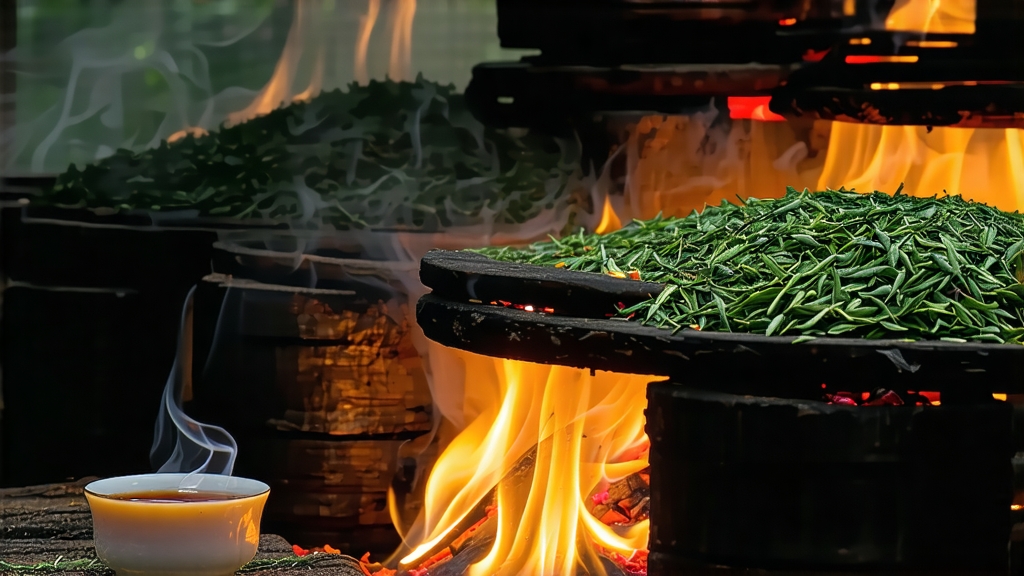
Long before Assam, Ceylon or Earl Grey entered the global lexicon, a small village deep in China’s Wuyi Mountains was already exporting a tea that would rewrite the history of world beverages. That village is Tongmu, that tea is Lapsang Souchong, and its story begins in the late Ming dynasty when a passing army forced farmers to speed-dry their tea over fresh pine fires. The accidental smoke gave birth to the very first fully oxidised leaf the world had ever tasted—what the Chinese still call hong cha, “red tea,” and the West later labelled “black.” From the docks of 17th-century Fujian, Dutch and British merchants carried the novel leaf to Europe, where it filled the porcelain cups of Parisian salons and London coffee-houses, igniting a fashion that would ultimately seed the tea gardens of India and Sri Lanka. In short, every modern black tea owes its existence to the pine-scented leaves of Lapsang Souchong.
Yet within China the name carries a narrower, almost sacred meaning. Only leaf picked inside the 600–1 200 m core zone of the Wuyi National Nature Reserve may claim the title “Zheng Shan” (“Original Mountain”) Xiao Zhong. Here a subtropical monsoon climate, mineral-rich lateritic soil and perpetual cloud cover slow the growth of the tea bushes, concentrating amino acids and volatile aromatics. Two main cultivars dominate: Cai Cha, a hardy indigenous shrub with small, tightly curled leaves, and the more recent Mei Zhan Xiao Zhong, prized for its honeyed undertone. Outside this 48 km² enclave, similar techniques produce “Waishan” (Off-Mountain) Souchong, but connoisseurs liken the difference to Grand Cru Burgundy versus generic pinot noir.
Processing begins before dawn in late April, when women wearing head-lamps pluck the standard “two leaves and a bud,” selecting only the tender middle leaf known as the zhong kai mian. The baskets are rushed to the village’s three-storey wooden houses where withering occurs on bamboo trays suspended over slow-burning pine embers. Unlike any other black tea, the fresh leaf is smoked while it withers, allowing phenols to bond with resinous terpenes even before oxidation starts. After 6–8 hours the leaf, now limp and fragrant, is rolled on rattling bamboo mats until the cell rupture rate exceeds 85 %. Oxidation follows in humid, pine-panelled rooms kept at 24 °C; the leaf reddens from edge to centre in exactly 110 minutes, a timing passed down through 24 generations and still checked by the master’s bare hand. Finally the tea is given a “second smoke”: the half-dried leaves are spread on sieves above a pinewood fire whose temperature is raised in three gentle steps to 80 °C, locking in the trademark tarry sweetness. The entire cycle consumes 18 hours and 60 kg of pine logs per kilo of finished tea, explaining why authentic Tongmu Lapsang retails for more than silver itself.
The resulting leaf is glossy, jet-black and slightly resinous to the touch; its aroma oscillates between smoked paprika, dried longan and the scent of a winter campfire. When brewed, the liquor is not the inky black many expect but a crystal-clear cinnabar edged in copper. The first sip delivers a wave of pine smoke, quickly followed by a mellow malt sweetness and a lingering note of cinnamon bark. The finish is clean, almost cooling, leaving the palate ready for another cup—a signature that separates the genuine article from the harsh, creosote-flavoured imitations still bulk-smoked for export.
To unlock these nuances, gongfu style is essential. Pre-heat a small 120 ml zisha or porcelain gaiwan with 95 °C water. Use 5 g of leaf—roughly two heaped teaspoons—rinsed for only three seconds to awaken the aromatics. The first infusion, 10 seconds, offers the most dramatic contrast between nose and cup: smoke up front, honey underneath. Subsequent steeps lengthen by five seconds each, revealing successive layers of cacao, roasted chestnut and a faint whiff of narcissus that locals call “Wuyi yun.” A quality Lapsang will yield seven infusions before the smoke recedes and the malt